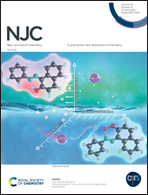Decomposition mechanism and morphological evolution of in situ realized Cu nanoparticles in Cu complex inks
Abstract
Cu complex inks are composed of Cu salts as metal precursors and complexing agents that effectively reduce the decomposition temperature of the Cu salts. The thermal decomposition of the complexed Cu salt provides the metal for the in situ formation of nanoparticles. Using Cu formate tetrahydrate as a metal precursor, the effect of the complexing agent, i.e. amino-2-propanol and hexylamine, its molar ratio compared to the Cu salt, the predrying and sintering parameters such as temperature and ramp rate, and additional organic solvents are investigated to understand the influence on the morphology of the in situ generated Cu nanoparticles. The additional solvents are used to adjust the viscosity for ink-jet printing and to control the formation of the nanoparticles. A pre-drying step with a slow ramp rate (5 °C min−1) is required before the sintering process to effectively control the evaporation of organics. However, the slow pre-drying process leads to the growth of in situ generated particles into the microscale range (2–5 μm). Adding polyethylene glycol 600 (PEG600) is observed to suppress the growth of nanoparticles and realize an ink-jet printable formulation, which is achieved even with low Cu content (<8 wt%) and dense and homogeneous traces with a bulk resistivity of 20.48 μΩ cm when sintered in a conventional oven for 5 min at 250 °C under a N2 atmosphere.



 Please wait while we load your content...
Please wait while we load your content...